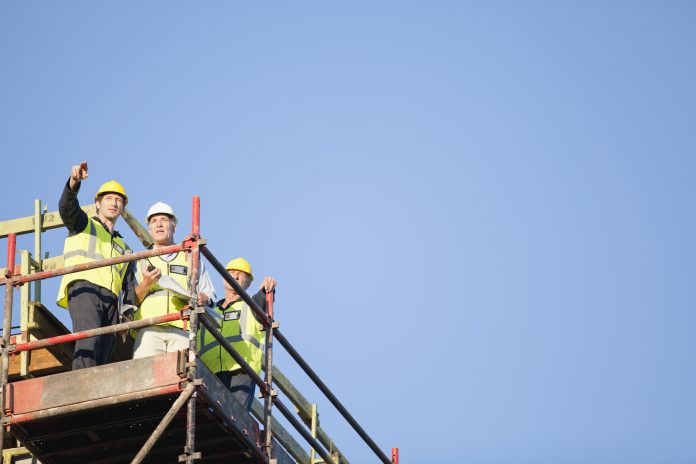With factors ranging from the aftermath of the pandemic on supply chains to inflationary pressures all impacting the delivery of construction projects, how can collaborative procurement keep projects on track?
AECOM’s Head of Advisory services for Infrastructure Edd Burton and Tom Douglas, Partner at Eversheds Sutherland specialising in construction and engineering projects, explain more about how collaborative procurement enhances the process across the entire project lifecycle.
To say the delivery of construction projects has become more complex in recent years is somewhat of an understatement. The conflict in Ukraine, Brexit and the Covid-19 pandemic have all caused disruption to labour markets and supply chains, contributing to soaring inflation. Construction projects have also been hit with difficulties in securing planning permission, increasing legislative requirements, such as the recently enacted Building Safety Act, and supply chain complexity.
The combination of all of these factors creates a very difficult environment in which to successfully deliver construction projects. This is feeding into pricing for projects as demonstrated by AECOM’s latest tender price index, which is tracking at 10.7% in the 12 months to Q1 2023.
Against this backdrop, it’s no surprise that the development and construction industries have been increasingly looking at how to do things differently. While the concept of collaborative procurement isn’t new, it is something the construction sector is increasingly looking to as it seeks to overcome the challenges it faces. It is also being considered as a model which better supports the delivery of environmental, social and governance (ESG) targets.
The Banwell Report said in the 1960s that the construction industry was not flexible enough to meet modern needs and calling for more collaboration. In the 1990s, the ground-breaking reports by Sir Michael Latham and BAA Chief Executive Sir John Egan – whom many see as the ‘godfathers’ of collaboration – precipitated the unprecedented collaborative behaviour on the successful construction of Terminal 5 at Heathrow, which is often benchmarked as a collaborative gold standard.
Over the past 20 years, collaborative procurement has entered the lexicon globally as a more proactive way of delivering projects in a range of sectors and markets. Australia has the longest history of modern collaborative contracting for delivering oil, gas and infrastructure projects.
Today, most major UK infrastructure projects include elements of collaboration in their procurement, contracting or delivery model. In part, this has been driven by the proliferation of the NEC forms of contract, which drive closer working between client and supply chain, and the recommendations in both the public and private sector Construction Playbooks, which champion the benefits of building long-term, mutually beneficial relationships across the entire supply chain.
In the current climate, we are increasingly seeing clients asking for support on collaborative procurement models, as they strive for a solution which can successfully deliver their required outcomes.
Why should I consider collaborative procurement for my project?
Put simply, because it can deliver significant benefits for a project or programme of works. At its heart, collaborative procurement aligns the outputs and incentives for the parties involved.
Clients and supply chains can lack an understanding of each other’s businesses and their drivers for success, whether that’s the speed of delivery for a developer, return on investment for an investor, or balancing cost and quality for a contractor. Collaborative procurement seeks to improve the trust and understanding between the parties, so that they are pulling in the same direction to achieve mutually beneficial outcomes.
Some of the more significant benefits that can be delivered through collaborative procurement models include:
- Flexibility to innovate – involving the supply chain early in the procurement of a project allows relevant specialists to apply their expert knowledge to the design process, refining the specification and output requirements. Allowing contractual flexibility for the supply chain to propose mutually beneficial alternative solutions during delivery promotes innovation throughout the project;
- Reduced cost and time – aligned to the above, early involvement of the supply chain can support improved productivity by considering how to efficiently deliver the project. It allows consideration of modern methods of construction, including off-site fabrication, to minimise waste and time on site. Proper integration can lead to fewer wasted activities and better interface across the disciplines;
- Improved standards and outcomes – working together to agree and properly define the required outputs, coupled with measurement against those outputs, gives a clear focus to the team on what needs to be delivered and the incentives for successful delivery. This can lead to better health, safety and environmental outcomes;
- Reducing and avoiding disputes – collaboration fosters a more open and trusting environment, minimising adversarial behaviours and reducing claims and disputes. With some forms of collaborative procurement the contractual arrangements would even look to a ‘zero claims’ approach for delays and defects, with those risks being managed in a different way through incentivisation and risk sharing commercial models.
Collaborative procurement is an opportunity to work differently, moving away from a zero sum transactional approach to delivery of projects.
Which approach is right for our project?
There will probably be many in the industry who have heard of the term collaborative procurement, but aren’t sure exactly what it means or if it’s right for them and their projects. It can be a complex area but for most projects even a light touch will deliver benefits.
There are a range of options when it comes to collaborative procurement models. At the most basic end of the range are models such as framework agreements and two-stage tendering / early supply chain involvement. While it may seem overly simplistic, frameworks which create longer term relationships between a client and their supply chain can be hugely beneficial in promoting effective partnerships, ensuring learning is carried from one project to another, in turn increasing design and delivery productivity to drive down cost.
A two-stage model drives closer working between the client team and supply chain during the design and specification phase to develop a solution which best meets the outcomes required for a development, including cost, time, building performance and ESG goals.
At the other end of the scale are alliancing and enterprise models, which are often used by infrastructure owners with long-term capital programmes. Alliancing models see multiple supply chain partners enter a single contract, or a series of bi-lateral contracts with an overarching alliance agreement, with responsibility for successful project and programme delivery equally shared.
Examples include Anglian Water’s @OneAlliance, which has been their model for the past 18 years. The @OneAlliance is incentivised to outperform budget on every project through a share of any underspend, with budgets ratcheted down annually to reflect efficiency gains the alliance should realise through the repetitive nature of the projects being delivered.
In the middle of the range are partnering models. With such models being generally underpinned by a target price commercial mechanism, used to incentivise client and supply chain to deliver the parties’ mutual outcomes for the project, together with an overarching partnering agreement setting project objectives, KPIs, incentives and governing relationships across the project team. Scoping documents will include details of the mechanics used to drive collaboration, such as joint risk management, collaboration charters and transparent data sharing.
Determining which model is right for your project will depend on a range of factors, including the scope and scale of the project, client experience in delivering under collaborative models, and the outcomes desired from the project. A bespoke delivery strategy should be developed for each project.
What does collaborative procurement involve?
To achieve the biggest benefits you will need a project, or programme of works, of relative complexity and sufficient scale to justify the up-front investment that is necessary to generate the benefits outlined above. A client organisation must allocate a greater level of resource and commitment to collaboratively procured projects than they might be used to. A clear vision and/or mission statement is required, which the project team can use as a focal point.
Setting the right behaviours and mindset at the outset is crucial to success. The parties will need to have the appetite and capability to collaborate, accepting that ‘best for project’ decisions will need to be taken over a ‘best for individual’ approach. This is a change in mindset for many organisations, but is crucial for success.
It is important to be comfortable with integrating the project team and empowering the supply chain to find solutions. Empowerment means trusting suppliers to make decisions that are best for the project. This can be supported by co-location of the project team, which will help create the right environment for collaboration, and allow team members to adopt a ‘one team’ mentality, leading to quicker decisions making in a joined up way.
Transparent, two-way sharing of information is the foundation of effective collaboration because it builds trust between parties. Sharing information about business objectives and project context (within the confines of the law) provides the team with a clear understanding that enables effective decision-making.
Collaborative procurement relies on all parties agreeing measurable outcomes and moving away from assessing supplier performance based on inputs. Trust is required throughout the supply chain if aims are to be achieved and expected behaviours demonstrated; in return suppliers will expect to make a fair profit and maintain cash flow.

A form of contract that supports and facilitates collaboration will be required. The contract will need to include equitable risk allocation / sharing, and include a commercial model that balances supplier risk and reward. There are now a number of standard form contracts that support collaborative procurement across the range of collaboration models. In all cases proper support in developing and drafting your contract strategy and documents is crucial to success.
Understanding collaborative procurement with AECOM and Eversheds Sutherland

Collaboration can bring benefits to any project or programme of works. The construction industry continues to face the ongoing headwinds of inflation, productivity challenges, affordability and squeezed margins.
Collaborative procurement models are a way to ensure that the industry manages these headwinds and has a long term sustainable future, in which all parties thrive.
AECOM and Eversheds Sutherland have written an easy to understand and accessible guide for all parties to understand the concept of collaborative procurement and how it can be implemented to deliver benefit to your projects, which you can find here.

















